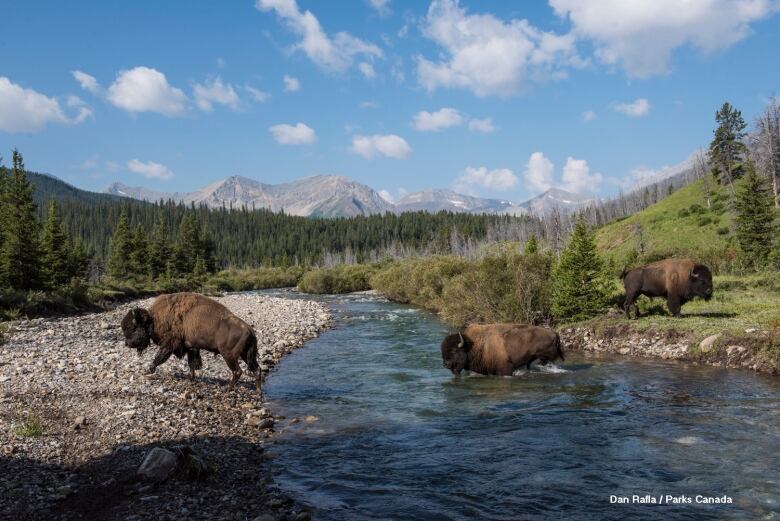Bison roam free in Banff National Park for first time in more than a century
'This is a dream come true for any wildlife biologist,' says project manager
Banff National Park now has free-roaming bison as an ambitious reintroduction project enters its next phase this week.
"For me, this is a dream come true for any wildlife biologist," project manager Karsten Heuer told reporters on Thursday.
"To have a chance to try to run a project to bring back North America's largest land mammal to Canada's first national park, it's been really, really emotional. It's an emotional week."

Bison used to be abundant on the Great Plains, which stretchfrom north of Edmonton down to Texas. Small numbers roamed what is now Banff National Parks for 10,000 years until they were nearly driven to extinction by human activity prior to the creation of the park in 1885.
While many remember what Parks Canada calls a "display herd" of bison housed in a paddock near the Banff townsite until 1997, this herd represents a return to wild animals.
A year and a half ago, six young bulls and 10 females, some pregnant, were transported from Elk Island National Park in crates by truck and helicopter to a fenced pasture about 40 kilometres north of the Banff townsite. It was called the soft-release pasture.
After two calving seasons, the animals have bonded with the area. There are currently 31 animals in the herd.
- Banff holds blessing ceremony with Indigenous elders before letting bison roam
- 'Made-in-Banff' bison calves born in park's backcountry for 1st time in more than 140 years
This week, the gates were opened and the bison travelled in the cover of night into the 1,200 square-kilometre reintroduction zone in theremote eastern slopes of Banff National Park.
"With the return we need to redefine how we think of Banff National Park and this new definition includes a landscape shaped once again by free roaming bison," Bill Hunt of Parks Canada said.

"Bison are what we call a 'keystone species.' They alter the food web and the landscapes around them in ways that increase biodiversity. They improve grazing for other ungulates like elk, due to the fertilized grasses they leave in their wake. They open the forest for birds and small mammals. Their heavy winter coats shed each spring to provide critical nesting material for alpine birds. They are an important food source for a range of predators and scavengers like wolverines and grizzly bears."
- Banff bison to roam free this summer in park for first time in more than a century
- 2017 | Wild bison roam Banff National Park for 1st time in more than century
GPS collars are used for thisfree-roaming stage of the project to track their movement and learn how they interact with other species.
"Over time they will create a vibrant mosaic of habitat that benefits bugs, birds, bears and hundreds of other species like they once did," Hunt said.

The five-year reintroduction pilot will be evaluated in the spring of 2022.

- MORE ALBERTA NEWS |Southern Alberta crops suffer as farmers contend with driest soil in 50 years
- MORE ALBERTA NEWS |Family of Taylor Toller, allegedly killed by boyfriend, says she was 'admired and loved'
- Read more articles by CBC Calgary, like us on Facebook for updates and subscribe to our CBC Calgary newsletter for the day's news at a glance.
With files from Radio-Canada













_(720p).jpg)


 OFFICIAL HD MUSIC VIDEO.jpg)
.jpg)



























































































